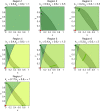Impulsive Fire Disturbance in a Savanna Model: Tree-Grass Coexistence States, Multiple Stable System States, and Resilience
- PMID: 34591211
- PMCID: PMC8484106
- DOI: 10.1007/s11538-021-00944-x
Impulsive Fire Disturbance in a Savanna Model: Tree-Grass Coexistence States, Multiple Stable System States, and Resilience
Abstract
Savanna ecosystems are shaped by the frequency and intensity of regular fires. We model savannas via an ordinary differential equation (ODE) encoding a one-sided inhibitory Lotka-Volterra interaction between trees and grass. By applying fire as a discrete disturbance, we create an impulsive dynamical system that allows us to identify the impact of variation in fire frequency and intensity. The model exhibits three different bistability regimes: between savanna and grassland; two savanna states; and savanna and woodland. The impulsive model reveals rich bifurcation structures in response to changes in fire intensity and frequency-structures that are largely invisible to analogous ODE models with continuous fire. In addition, by using the amount of grass as an example of a socially valued function of the system state, we examine the resilience of the social value to different disturbance regimes. We find that large transitions ("tipping") in the valued quantity can be triggered by small changes in disturbance regime.
Keywords: Bistability; Impulsive differential equations; Resilience; Savanna; Tipping points; Transient dynamics.
© 2021. The Author(s).
Figures









Similar articles
-
An impulsive modelling framework of fire occurrence in a size-structured model of tree-grass interactions for savanna ecosystems.J Math Biol. 2017 May;74(6):1425-1482. doi: 10.1007/s00285-016-1060-y. Epub 2016 Sep 22. J Math Biol. 2017. PMID: 27659304
-
A probabilistic analysis of fire-induced tree-grass coexistence in savannas.Am Nat. 2006 Mar;167(3):E79-87. doi: 10.1086/500617. Epub 2006 Jan 30. Am Nat. 2006. PMID: 16673339
-
The impact of inter-annual rainfall variability on African savannas changes with mean rainfall.J Theor Biol. 2018 Jan 21;437:92-100. doi: 10.1016/j.jtbi.2017.10.019. Epub 2017 Oct 18. J Theor Biol. 2018. PMID: 29054812
-
Savanna fire regimes depend on grass trait diversity.Trends Ecol Evol. 2022 Sep;37(9):749-758. doi: 10.1016/j.tree.2022.04.010. Epub 2022 May 13. Trends Ecol Evol. 2022. PMID: 35577616 Review.
-
Linking resource- and disturbance-based models to explain tree-grass coexistence in savannas.New Phytol. 2023 Mar;237(6):1966-1979. doi: 10.1111/nph.18648. Epub 2022 Dec 25. New Phytol. 2023. PMID: 36451534 Review.
Cited by
-
Pattern Formation in Mesic Savannas.Bull Math Biol. 2023 Nov 27;86(1):3. doi: 10.1007/s11538-023-01231-7. Bull Math Biol. 2023. PMID: 38010440 Free PMC article.
-
Is resilience a unifying concept for the biological sciences?iScience. 2024 Apr 10;27(5):109478. doi: 10.1016/j.isci.2024.109478. eCollection 2024 May 17. iScience. 2024. PMID: 38660410 Free PMC article. Review.
-
An immuno-epidemiological model for transient immune protection: A case study for viral respiratory infections.Infect Dis Model. 2023 Jul 16;8(3):855-864. doi: 10.1016/j.idm.2023.07.004. eCollection 2023 Sep. Infect Dis Model. 2023. PMID: 37502609 Free PMC article.
-
Emergent structure and dynamics of tropical forest-grassland landscapes.Proc Natl Acad Sci U S A. 2023 Nov 7;120(45):e2211853120. doi: 10.1073/pnas.2211853120. Epub 2023 Oct 30. Proc Natl Acad Sci U S A. 2023. PMID: 37903268 Free PMC article.
References
-
- Archer SR, Andersen EM, Predick KI, Schwinning S, Steidl RJ, Woods SR (2016) Woody plant encroachment: causes and consequences. In: Briske D (ed) Rangeland systems. Springer, pp 25–84
-
- Archibald S, Roy DP, van Wilgen BW, Scholes RJ. What limits fire? an examination of drivers of burnt area in Southern Africa. Glob Change Biol. 2009;15(3):613–630. doi: 10.1111/j.1365-2486.2008.01754.x. - DOI
-
- Batllori E, Ackerly DD, Moritz MA. A minimal model of fire-vegetation feedbacks and disturbance stochasticity generates alternative stable states in grassland-shrubland-woodland systems. Environ Res Lett. 2015;10(3):034018. doi: 10.1088/1748-9326/10/3/034018. - DOI
-
- Baudena M, D’Andrea F, Provenzale A (2010) An idealized model for tree-grass coexistence in savannas: the role of life stage structure and fire disturbances. J Ecol 98(1):74–80
Publication types
MeSH terms
LinkOut - more resources
Full Text Sources

